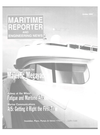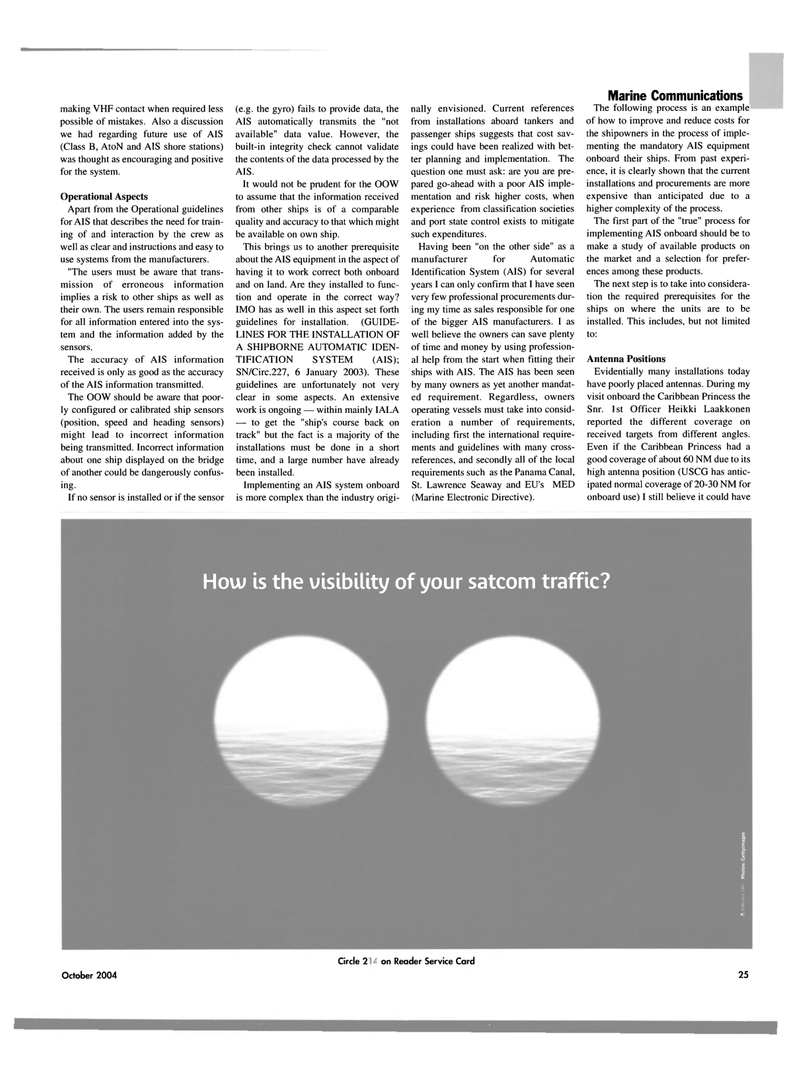
Page 25: of Maritime Reporter Magazine (October 2004)
The Marine Communications Edition
Read this page in Pdf, Flash or Html5 edition of October 2004 Maritime Reporter Magazine
making VHF contact when required less possible of mistakes. Also a discussion we had regarding future use of AIS (Class B, AtoN and AIS shore stations) was thought as encouraging and positive for the system.
Operational Aspects
Apart from the Operational guidelines for AIS that describes the need for train- ing of and interaction by the crew as well as clear and instructions and easy to use systems from the manufacturers. "The users must be aware that trans- mission of erroneous information implies a risk to other ships as well as their own. The users remain responsible for all information entered into the sys- tem and the information added by the sensors.
The accuracy of AIS information received is only as good as the accuracy of the AIS information transmitted.
The OOW should be aware that poor- ly configured or calibrated ship sensors (position, speed and heading sensors) might lead to incorrect information being transmitted. Incorrect information about one ship displayed on the bridge of another could be dangerously confus- ing.
If no sensor is installed or if the sensor (e.g. the gyro) fails to provide data, the
AIS automatically transmits the "not available" data value. However, the built-in integrity check cannot validate the contents of the data processed by the
AIS.
It would not be prudent for the OOW to assume that the information received from other ships is of a comparable quality and accuracy to that which might be available on own ship.
This brings us to another prerequisite about the AIS equipment in the aspect of having it to work correct both onboard and on land. Are they installed to func- tion and operate in the correct way?
IMO has as well in this aspect set forth guidelines for installation. (GUIDE-
LINES FOR THE INSTALLATION OF
A SHIPBORNE AUTOMATIC IDEN-
TIFICATION SYSTEM (AIS);
SN/Circ.227, 6 January 2003). These guidelines are unfortunately not very clear in some aspects. An extensive work is ongoing — within mainly IALA — to get the "ship's course back on track" but the fact is a majority of the installations must be done in a short time, and a large number have already been installed.
Implementing an AIS system onboard is more complex than the industry origi- nally envisioned. Current references from installations aboard tankers and passenger ships suggests that cost sav- ings could have been realized with bet- ter planning and implementation. The question one must ask: are you are pre- pared go-ahead with a poor AIS imple- mentation and risk higher costs, when experience from classification societies and port state control exists to mitigate such expenditures.
Having been "on the other side" as a manufacturer for Automatic
Identification System (AIS) for several years I can only confirm that I have seen very few professional procurements dur- ing my time as sales responsible for one of the bigger AIS manufacturers. I as well believe the owners can save plenty of time and money by using profession- al help from the start when fitting their ships with AIS. The AIS has been seen by many owners as yet another mandat- ed requirement. Regardless, owners operating vessels must take into consid- eration a number of requirements, including first the international require- ments and guidelines with many cross- references, and secondly all of the local requirements such as the Panama Canal,
St. Lawrence Seaway and EU's MED (Marine Electronic Directive).
Marine Communications
The following process is an example of how to improve and reduce costs for the shipowners in the process of imple- menting the mandatory AIS equipment onboard their ships. From past experi- ence, it is clearly shown that the current installations and procurements are more expensive than anticipated due to a higher complexity of the process.
The first part of the "true" process for implementing AIS onboard should be to make a study of available products on the market and a selection for prefer- ences among these products.
The next step is to take into considera- tion the required prerequisites for the ships on where the units are to be installed. This includes, but not limited to:
Antenna Positions
Evidentially many installations today have poorly placed antennas. During my visit onboard the Caribbean Princess the
Snr. 1st Officer Heikki Laakkonen reported the different coverage on received targets from different angles.
Even if the Caribbean Princess had a good coverage of about 60 NM due to its high antenna position (USCG has antic- ipated normal coverage of 20-30 NM for onboard use) I still believe it could have
How is the visibility of your satcom traffic?
October 2004
Circle 260 on Reader Service Card 25

 24
24

 26
26
